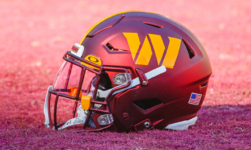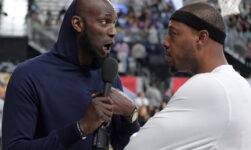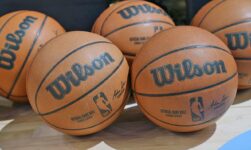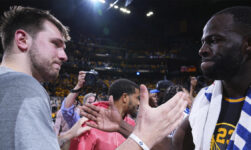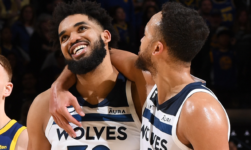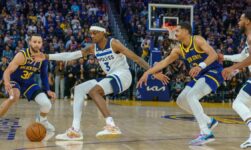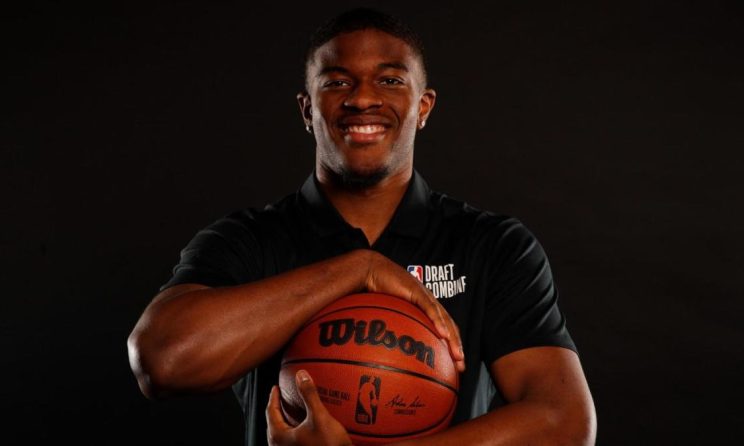
E.J. Liddell was told he was too heavy, too slow, undersized and probably not ready for the NBA. The Ohio State star was also told this was his moment to maximize. It would be best if he left college, some said.
Thanks to the agents and actors who make the NBA machine daunting (by design) to navigate, the messages to Liddell were as mixed as his feelings about going through the pre-draft process to begin with.
His college coach, Chris Holtmann, flew out to see him in Santa Barbara, California, in the spring of 2021 when Liddell was going through workouts and trying to determine if he was finished playing for Ohio State. Holtmann didn’t press his best player, didn’t try to sway his thinking one way or the other. A year ago, at 20 years old, Liddell heard that leaving because of his age would be a big reason — a positive factor — and one that would help him get drafted. The younger you are, the better you can be. Ageism has become a dominant element in draft evaluations.
“He also was a first team all-league guy [that] year, and there was a thought: What more can you do?” Holtmann told CBS Sports. “People told him, ‘Hey, you’re going to hurt your draft stock by coming back.’ He heard that from some people. But he was able to parse what was true, what was reality and what was just … talk.”
Realistically, Liddell was a fringe NBA pick one year ago. He was coming off a good sophomore season, one that ended in stunning disappointment with a loss in the first round to No. 15 seed Oral Roberts. The whispers about Liddell’s then-teammate, Duane Washington, leaving OSU early to chase the NBA wound up being true. With Washington gone, Liddell’s stay-or-go decision meant as much to Ohio State’s 2021-22 prospects as nearly any other player who was debating leaving school.
For Liddell, it turned out to be hardly a tough decision at all. After an inconsistent showing at G League camp, he felt like he was a year away from being who he wanted to be as a college player and a pro prospect.
“If I stayed in I would have made a team and might have been drafted, might have been picked in the second round,” Liddell told CBS Sports. “But I was told my shot wasn’t the best, I needed to continue play better defense and be in a lot better shape. What made me decide to go back to school? I felt like I was settling if I left.”
There’s a twist on conventional thought. “Settling” meant leaving school. Most players would see it the opposite way. But Liddell isn’t wired like most others.
“He’s one of the best kids I’ve ever coached, so you begin with the fact he’s smart, he’s perceptive, he’s an unbelievable, hell of a kid,” Holtmann said. “It sets you up to be able to have real conversations. You can have real conversations with kids like E.J. What’s best for you? And real conversations with his mom and his dad and you don’t have to feel like you’re dancing around or walking on eggshells. We all know kids want to be NBA players as soon as they can. But for me, every single conversation centered around what was ultimately best for E.J., and that was fluid this time last year. Pretty fluid.”
Going back to school for extra year has become undervalued
Liddell played himself into first-round value this past season. That extra year, which amounted to playing three seasons of college basketball, turned out to be a fantastic decision. He went from 6.7 points per game to 16.2 to 19.4 in his three years at OSU. Liddell’s rebounds climbed from 3.8 to 6.7 to 7.9 per game. His effective field goal percentage boosted from 47.7% to 51.5% to 54.6%. His efficiency across the board improved. Free-throw rate, 2-point percentage, 3-point percentage, foul shooting, block rate, assist rate — everything increased from freshman to sophomore to junior season.
He is unquestionably much better now and more prepared to play in the NBA than 12 months ago, even five months ago. Liddell is riding a wave of momentum into the NBA Draft, and somewhat quietly, he’s positioned himself to be one of only two power-conference upperclassmen who will likely be selected in the first round. The other: Kansas All-American Ochai Agbaji, who like Liddell, passed on NBA temptations a year ago and made his life better because of it. There are lessons to be learned here.
There’s even some speculation, because of his stellar reputation off the floor and how solid he is as a teammate, that Liddell could be creeping closer to top-20 status. Holtmann said he’s getting feedback from NBA people, general managers included, that indicates to him Liddell won’t last past the mid-20s. One source said that a few teams who hold reputations for how well they scout, how much time, money and resource they dump into evaluations, those franchises have been asking about Liddell for weeks. Word’s gotten out. With the NBA Draft less than three weeks away, Liddell has quietly been one of the steadiest risers in the past six weeks.
Why? Scouts got to see Liddell with the ball in his hands again as of late. At the combine and pro days, the evidence is there for everyone to see. Sometimes it can be as simple as that. The tape matters, but what you’ve done with your skillset since the season ended can also communicate work ethic and seriousness to the craft. It’s not everything, but it’s something. The process adds clarity, or at least the illusion of it. There are going to be a lot of unsuccessful guesses made on June 23, but almost no one will realize it that night.
A year after Liddell was short of desirable in his workouts and testing, he blasted through expectations in May. At 6-7 and with a tempting 6-11 wingspan, Liddell recently weighed in at the NBA Combine at 244 pounds, a weight he said will drop to 235 as he burns more off during the season. While training at P3 in Santa Barbara, Liddell took 29,000 recorded shots over a 6.5-week period, up until the combine, and rated tremendously well in athleticism tracking. That bore out at the combine, where his standing vertical jump of 35.5 inches ranked No. 1 among all power forwards. His testing in 2022 was vastly superior to a year prior.
“Yeah, I’m not that explosive — I just averaged 2.6 blocks,” Liddell said with a chuckle.
This isn’t a rags-to-riches story (Liddell was a top-50 high school prospect out of Belleville, Illinois, and the first major commit to OSU under Holtmann), but rather a potential vintage case of a super-solid eventual pro hiding in plain sight. He was one of the best college players last season. Of course, being great in college doesn’t immediately associate with being a desirable NBA prospect; just ask Drew Timme, Oscar Tshiebwe and Armando Bacot.
Liddell’s not as big as those bigs. He’s also got better touch and a better knack for blocking shots. It’s the blocked shots that are probably going to get him into the first round. He averaged 2.6 last season and did so at an 8.5% rate when he was on the floor. This helped Liddell rank as the fifth-most valuable player in the sport, according to KenPom.com. The efficiency numbers are undeniable. He took more 3-pointers and made a higher rate of them than ever before. Sustained efficiency is a key component to making a player a desirable draftee. Liddell has this in spades.
Is he going to be an All-Star? Probably not. But what are teams picking in that 16-30 range looking for? Stability just as much as value. Liddell could grow to be able to guard four positions and make it as a star role player. In fact, there’s one player in particular who keeps getting attached to Liddell: Grant Williams. Even KenPom’s player-comparison algorithm closely aligns Williams’ 2018-19 season with Liddell’s sophomore campaign. Size-wise, it fits. A couple of 6-7 guys hanging around 240 pounds who aren’t elite-level athletes and earned their reputations by doing a lot of little things in a variety of ways. It’s a fair comp. But if you ask scouts, they’ll tell you Liddell is more athletic than Williams. He’s longer and a bit bigger. Just don’t call him undersized. He hates it. It’s a mental note that is lingering in his head at all times.
There might be 40 players more exciting than Liddell in this draft, but there might not be 15 of them who will prove better in the long run.
Getty Images
Every draft class is a world unto itself, but Williams went 22nd in 2019. Now he’s been a key cog in getting the Boston Celtics to the NBA Finals. That’s certainly not hurting Liddell’s top-25 case. Neither are two other guys who’ve played deep into the NBA Playoffs, both of whom were called undersized and were undersold for how they looked, how their playing styles weren’t considered to be something that would naturally translate to the NBA. As a result, they waited until the second round to be drafted.
“I hear I’m undersized every day. That’s annoying,” Liddell said. “I guess I’m undersized, but you see guys who are in the conference finals. P.J. Tucker, Grant Williams, Draymond Green, and I’m pretty sure they don’t consider themselves undersized in their heads. Truthfully, when it comes to me, I’m a basketball player. I don’t think I’m undersized, I go on the court and do what I’m asked to do. … I’m stronger than most people and you can’t teach heart, truthfully.”
Tucker went 35th in 2006 NBA Draft, took a five-year basketball journey in leagues around the world, then made it back to the NBA in 2012, where he’s been a factor on winning teams for the better part of a decade. Green, who is on his way to the Hall of Fame, was also selected 35th overall six years after Tucker.
Inside Liddell’s game, why teams are so intrigued
The knocks on Liddell, aside from the debate on his body type and how it fits at power forward, mostly revolve around his jump shot. That is still a work-in-progress. Some scouts believe he may have trouble getting off the shot against NBA defenders, that adjusting to the game’s quickness in one-on-one situations for shot creation could keep him from ever becoming a top-three offensive option on a team. His shot might need a bit more arc to give him the best chance to succeed. Liddell understand this, and had no problem self-evaluating his flaws. When asked what attribute he can go from good-to-great at in the coming years, he said: “My lateral quickness on the defensive end. I feel like I’m at a 7 right now, but knowing me and how hard I work, I’ve always been on an upward trajectory.”
His style can sometimes belie his athleticism. Liddell is a vintage case of a player who can show you what he can do in the box score just as much as outside of it. His game has been a steady evolution, one with more room to grow, which is what is exciting the teams that have moved him higher on their boards. As a recruit he was a 15-feet-and-in kind of player. Had some skill on the low block, used his body and had some boost to him. His mom played volleyball at Illinois State, and that bounciness and genetic makeup is evidenced in his expert timing in blocking shots. He benefits from a system and structure. There are some franchises that will know what to do with him and others that will not. At Ohio State, he excelled when paired next to mature guards who could play through or off him.
“Clear leader and consistently the hardest worker on the team,” Holtmann said. “Never sitting on the sideline, never sitting out a drill. I never got the sense he was worried about getting injured and what that might mean for him. It was just: let me continue to prove myself over and over again, and that’s because that’s who E.J. is.”
When Liddell played five-on-five a year ago in G League camp, he was bad. He didn’t know the players, the ball didn’t stick, and he was asked by a coach who he didn’t know to do things he didn’t do.
“My coach told me to stand in the corner and take spot-up 3s and I was like, ‘Man, I’ve never done that in my life. I’ve never shot corner 3s,'” Liddell said. “When it came to 5-on-5s, that didn’t showcase me or help show how I can help to contribute to winning basketball. My tape, my game, how many minutes I played this past year showed that.”
To judge some players in foreign situations can backfire. Backfire for the player, backfire for the evaluators. Because of his experience, basketball intelligence, athleticism and defensive aptitude, some NBA insiders believe Liddell will be more game-ready as a rookie than a lot of players taken ahead of him. Liddell is a “kinetic mover,” meaning that the way he moves in space, reacts on defense and positions himself amongst teammates, there is a reliable fluidity to it. It’s not so much burst as it is a constant breach against the person he’s defending. He’ll surprise you with how much ground he can cover. In short: Liddell’s lateral capability grades out more like a lean wing than a traditional 4. Beyond this, and his most valuable trait being the elite shot-blocking for his size, Holtmann said Liddell’s best skill is his touch, be it on shots or going to work around the rim.
“I am a big, massive, 1,000% believer in him being a very productive player,” Holtmann said. “I really can’t say enough good things about him.”
He’s the type of player who can help your team win just a few more games this season, be that special ingredient in a playoff series, the guy kind of guy any team that makes the Finals needs on its roster to get there. He’s not a pouter. He doesn’t get vocal or irritated about his touches.
Liddell has already met with Chicago, Milwaukee and Denver. Another workout is scheduled for this weekend, then seven more in the next near-three weeks.
“I did most of my research with all of the teams, the roster, what they need, what they’re looking for,” he said. “When it comes to deciding to stay or leave, it’s all believing in yourself. I went back to school because I believed I could improve my game, believe I could be a better player and believed I could show more than what people thought I could do. It was about trusting. Trusting putting the work in. I wanted to hear my name called. I wanted to be in New York and I’m still working toward that right now. The job is not over.”
More than 60 of 2022’s underclassmen who are staying in the NBA Draft pool are first-time early entrants who have expired their eligibility and will not return to college. They are not taking the path Liddell took. Many of them aren’t as good now as Liddell was a year ago. There’s a lot to be said for a player having belief in himself, trusting the college experience and not allowing pressure from outsiders to push him to chase the NBA earlier than he might truly feel comfortable with. Liddell knew he wasn’t ready. There were players last year who weren’t ready either. They went undrafted, aren’t on NBA rosters, their college eligibility has expired and who knows what professional track awaits those players in the years to come.
Not the flashy pick. The reliable one. Had Liddell taken the leap a year ago, he might be in basketball Siberia right now. Amazing what one more year of hard work and faith in college basketball can do to change everything. That’s a story we should try to tell a little more often.

